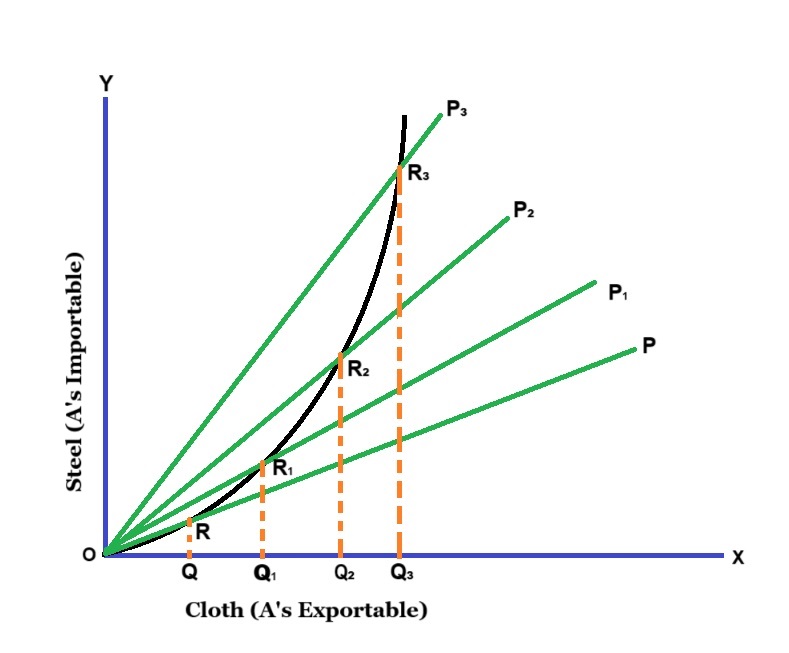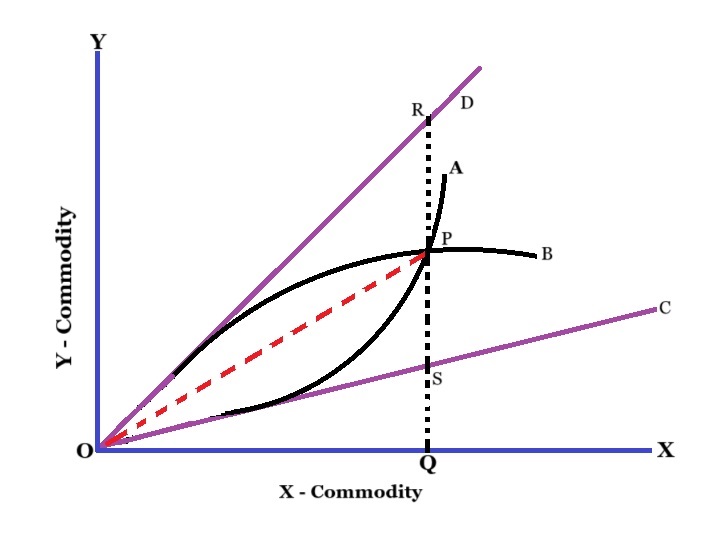Hello Dear Friends, Welcome to my Website KhanStudy.in and also thank you very much for come to my website. In today’s article we are going to know the concept of Offer Curve. So let’s discuss in details.
Table of Contents
What is Offer Curve?
The concept of offer curve or Reciprocal demand curve originally given by Marshall and Edgeworth. The trade offer curve or reciprocal demand curve indicates what quantities of a particular commodity that one country is willing to offer in exchange of certain quantities of another commodity.
In other words, the offer curve or reciprocal demand curve shows that the different quantities of a particular commodity demanded by the one country from the other at the different relative prices of their products and the offer curve is also known as reciprocal demand curve.
Derivation of Offer Curve
For the derivation of offer curve suppose, there are two countries A and B. X is the exportable commodity for country A while Y is the exportable commodity for country B. If the price of X continuous to increase relative to the price of Y then the offer curve of country A can be derive which shown in below figure –
In the above figure, originally the price ratio of two commodities is indicated by the slope of the line OP. If the price of X rises more relatively to the price of Y, the slope of price line or international exchange ratio line become more and more steep as shown by the line OP1, OP2, and OP3. As the price of X rises relatively more than Y, the demand for X in country B increase at a decreasing rate.
On the other hand, Country A can purchases more quantities of Y at an increasing rate. If R, R1, R2 and R3 are the points of exchange than the quantities exchange between A and B are OQ of X and RQ of Y, OQ1 of X and R1Q1 of Y, OQ2 of X and R2Q2 of Y and OQ3 of X and R3Q3 of Y. So, now joining R, R1, R2, and R3 we will get a curve that is known as Offer Curve (OA) of country A.
J.S. Mill’s Approach to Gains from Trade in terms of Trade Offer Curve
The distribution of gains from trade was provided by J.S. Mill. He attempted to analysis both the gains from trade and their distribution among the trading countries. He emphasised upon the concept of reciprocal demand that determines the terms of trade which is a ratio of quantity imported to the quantity exported by the given country.
The distribution of gains from trade can be explained with the help of offer curves –
In the above figure on OX axis we measure X commodity which exported by country A and OY axis we measure Y commodity which is exported by country B. In the figure, OA and OB are the offer curves of countries A and B respectively. Here, OC and OD are the domestic exchange ratio lines for countries A and B respectively.
In the figure, P is the point of exchange where OA and OB are cut each other.
TOT (Terms of trade) for at
P=QM/QX
=PQ/OQ
= Slope of line OP.
If the line OP gets closer to OD, the terms of trade becomes favourable to country A and unfavourable to country B. Here, before trade country A was willing to exchange SQ units of Y for OQ units of X. After trade, it gets or willing to to exchange PQ units of Y for OQ units of X. Therefore, the gain from trade for country A is PQ-SQ=PS.
Similarly, if the OP line gets closer to OC, the TOT becomes unfavourable to country A and unfavourable to country B. Before trade, country B was willing to export RQ units of Y for OQ units of X. After trade, it gets PQ units of Y for OQ units of Y. Therefore, the gain from trade for country B is RQ-PQ=RP.
Here, As the point of exchange P gets closer to the line OD, the share of country A in the gain from trade will rise and that of country B will fall and vice-versa. In this way, the gain is distribution on measured with the help of offer curves.



